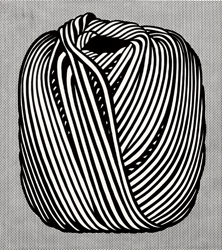1961–66
In the early 1960s, as Lichtenstein was producing his War and Romance comic panels, he was simultaneously working on a series drained of Pop color and narrative. Continuing to mimic the graphic conventions in mass-produced printed matter—in this series, newspaper advertisements and mail-order catalogues—he created over 50 black-and-white works on paper and canvas, as well as ceramic sculptures, of insistently ordinary, everyday objects.
Pop works of the period like Look Mickey (1961) involved an intricate compositional choreography. In the Black and White works, Lichtenstein intensified his focus on subject and scale. The objects here are centered on the canvas, or "islanded," as Lichtenstein phrased it. He also experimented with treating the painted canvas as an object, as in Portable Radio (1962), which includes a functional leather strap, or Compositions I (1964), a grossly inflated facsimile of a student notebook.
The year 1962 marked Lichtenstein's transition to machine-made, perforated metal screens, through which he painted by hand his trademark dots. The staggered rows of holes produced an optical phenomenon, a banding effect, which is evident in the background of Magnifying Glass (1963). The optical illusion is far less present in the "magnified" portion of the painting, where the increased amount of white space counteracts the retinal effect produced by the dotted background.
Optical effects are also present in works that do not incorporate dots. Pattern and repetition create the dizzying tread of Tire (1962), a painting evoking contemporary black-and-white Op art (short for Optical art) works by artists such as Bridget Riley and Victor Vassarely, while minimal detail was used with stunning results in Golf Ball (1962) to express pattern and volume.
Roy Lichtenstein. Ball of Twine, 1963. © Estate of Roy Lichtenstein. Courtesy of Christie's.

